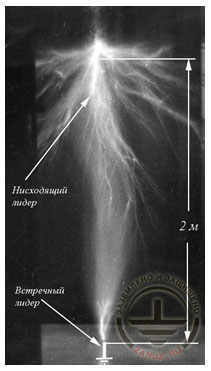Is it possible to control the point of the downward lightning strike? Any expert will answer "yes" to this question without hesitation. If you ask him about reasoning, you will surely hear a detailed exposition of the Gold hypothesis in response. It says, that the point of the lightning strike is determined by the starting place of a high temperature plasma channel of high conductivity from the ground facility. It is called the counter leader (Fig. 1).

It intercepts the leader channel of the downward lightning, which falls to the ground from a thundercloud. Impact control point actually comes down to counter a leader control. In the moment of its launch at the top of the building or at the top of the lightning rod there is no particularly strong electric fields, and the physical characteristics of the plasma in the channel are not much different from the laboratory sparks characteristics, the length of which have long exceeded one hundred meters in modern experiments. The experts have high-voltage sources for initiating such long spark discharges. They may be well applied both to influence the launch conditions and the development of the counter leader in storm conditions.

Figure 1. Downstream and counter leaders in a laboratory experiment
(static photo with a minor display)
Нисходящий лидер – downward leader
Встречный лидер – counter leader
Put the question in another plane - whether is it possible to control the point of lightning strike in the interest of practical lightning protection? Now, you can hardly get a quick and clear answer. Too many factors need to be analyzed. The first of them is cost. Traditional costs for external lightning protection are usually measured in percentage shares from the value of the protected structure. Therefore, the source of control actions must be cheap. And it should be fairly simple and should not need to be in-service inspection, otherwise it is difficult to count on the massive use of active lightning rods. Finally, the most important thing. An active lightning rod should be reliable. Modern technical facilities require reliable protection against direct lightning strikes at the level of 0.999. And this despite the fact that the electrical parameters of the lightning discharge vary within two orders of magnitude. Another source of control actions have to be fast enough because the channels in multi-component lightning often develop at intervals of less than 0.1 seconds, and often go on quite different trajectories. In lightning protection each such component has to be considered as a separate lightning.
It is necessary to evaluate all active lightning rods offered today from this perspective.
E. M. Bazelyan, DEA, professor;
Power Engineering Institute to the name of G.M. Krzhizhanovsky , Moscow;
a recognized Russian expert in the field of grounding and lightning protection.
1. Phases of the counter discharge development
Lightning protection - one of the engineering disciplines, where a specialist cannot do without a clear idea about the physics of the process. It majorly concerns the development mechanism of a counter leader, with which the search of simple technical solutions to improve the protection against direct lightning strikes is naturally connected.
The section provides a brief overview of gas-discharge phenomena ina counter discharge, such as:
2. Energy consumption of control actions on a lightning
We have to note the complexity of the technical issue that should be solved by the creator of the source of control actions for active lightning rods in a very limited technological space. In fact, the problem becomes even more serious when we talk about the source equally suitable for lightning rods of moderate height, say, - 15 - 20 m.
3. What is offered by companies producing active lightning protection
A variety of structures of active lightning rods is united by a rather poor description of their technical characteristics, in particular those which directly or indirectly determine the effectiveness of the protective action. You will be shown a certificate, which will confirm the ability of metal structures of a lightning rod to withstand lightning pulse current of the limiting amplitude, but you are unlikely to find any data on the experimental verification of the protective action of lightning rods, their zones of protection, indicating specific reliability.
The section devoted to a review offered by various manufacturers of active lightning rods.
4. Testing the efficiency of active lightning rods
The section provides an overview of national and foreign researches aimed at assessing of active lightning rods efficiency.
5. If ESE lightning rods functioned properly
It is useful imagine, at least for some time, that an active air lightning rod operates in accordance with the stated characteristics. What are the consequences of such a lightning rod installation on any structure?
How to increase the contraction area, and correspondingly, the number of strokes per year, read this section.
Related Articles:



